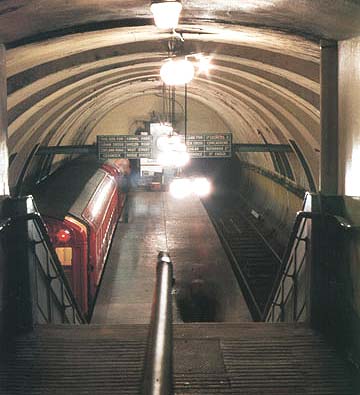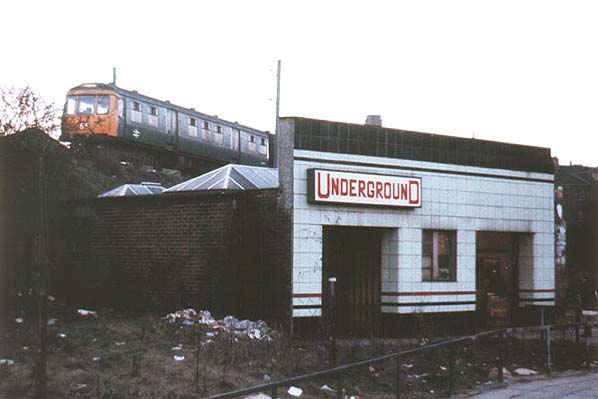|
Notes: Merkland Street was opened in 1896, as part of the Glasgow
district Subway, which formed the basis of toady's Glasgow Underground.
The station was situated on the north of the river, and proved
very popular, especially during the shipyards era, with workers
going from one side of the river Clyde to the other!
When the Glasgow Corporation Transport decided to replace the
cable haulage with electric traction, reusing the existing cars,
trials were carried out between Merkland Street and Copeland
Road (now Ibrox) Station. To allow this, the original timber
platforms at Merkland Street, Govan Cross, and Copeland Road,
had to be rebuilt in concrete.
In November 1940, a German plane was flying over Glasgow, and
dropped a bomb, probably intended for the Clyde shipyards and
naval establishments. The bomb landed on Beith Street bowling
green, about 50 metres away from Merkland Street, penetrated
the soft surface above the subway tunnels, and exploded either
above or inside the tunnels. The subway was closed for 131 days
while repairs were carried out. The scars are still evident
today, as south of Partick station, the cast iron tunnels change
to partly brick, marking the site of the bomb explosion. No
one was injured
By the 1970's the Glasgow Underground was run down, and in desperate
need of refurbishment. The Greater Glasgow Passenger Transport
Executive, whose predecessors, Glasgow Corporation Transport,
had acquired the subway in 1923, were given authority to modernise
the subway in 1974, and after funding and planning had been
sorted out, the scheduled closure was set for 28th May 1977.
 Merkland Street Station - Photo by George
Watson
Merkland Street Station - Photo by George
Watson |
As part of the plans, 14 of the stations were to be modernised,
and five of those were to be excavated, and rebuilt, with
flank platforms, rather than island platforms. The 15th
station, Merkland Street, was to be closed, and replaced
by a new station, just under 25 metres away, called Partick.
This new station, which would also have flank platforms,
would interchange with Scotrail's North Clyde electrics.
The reason for building a new station was that, had the
Merkland Street site been retained, it would've been difficult
to build new stairs or escalators, through the embankment,
that the BR line sits upon, for new flank platforms. Hence,
the decision was made to build a new station instead.
|
Merkland Street ended up closing a week early, after cracks
were seen in the roof of Govan Cross (now Govan) platform chamber,
as a result of preparatory work for the new flank platforms
there. The GGPTE decided not to resume the service until after
the modernisation had been completed. This was on the 16th April
1980.
Merkland Street chamber still exists, as trains on both circles
pass through it. If you watch carefully, or listen, you'll see
the chamber just before Partick (outer circle), or just after
(inner circle), and can also hear the noise change for a few
seconds. The platform chamber cannot be accessed from Partick
station
After the system closed for modernisation in 1977, the Glasgow
Museum of Transport, which was then based in the former Coplawhill
tramcars works, carefully dismantled the station masters box,
which was then on the platform; it contained circuit breakers
and other items - the box now forms a subway exhibit. The Merkland
Street T-irons, which provided lighting for the trains and controlled
the signalling, were also removed; under the modernisation,
with pointwork to reach the depot, the t-irons were obsolete.
The destination gantry and clock were also removed, and taken
for storage by the museum. When the Glasgow transport Museum
moved to it's new site at the Kelvinhall in 1983 (1/4 away from
Kelvinhall subway station), the subway exhibit was rebuilt into
a 1930's street scene. The exhibit consists of an island platform,
the destination gantry, the station masters box, and some old
subway cars. One is car 1, another is trailer 39 and the third
is 1/2 of car 4.
Further reading: Circles
Under The Clyde - A history of the Glasgow Underground by
John Wright & Ian Maclean, published by Capital Transport,
ISBN 1-85414-190-2.
For information about the Glasgow Subway today see the Strathclyde
Partnership for Transport (SPT) web site and click on 'subway'.
The New
York City Subway web site also has a page on the Glasgow
underground.
|


 Home Page
Home Page 

 Home Page
Home Page